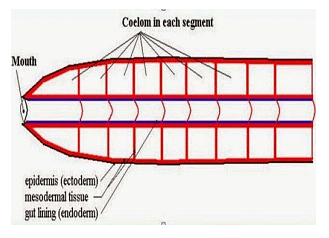UPSC Exam > UPSC Notes > Zoology Optional Notes for UPSC > Annelida: Metamerism
Annelida: Metamerism | Zoology Optional Notes for UPSC PDF Download
| Table of contents |

|
| Metamerism in Annelida: A Detailed Exploration |

|
| Types of Metamerism |

|
| Theories on the Origin of Metamerism: Unraveling the Evolutionary Enigma |

|
| Significance of Metamerism |

|
Metamerism in Annelida: A Detailed Exploration
Occurrence of Metamerism
- Metamerism is first observed in the animal kingdom within the phylum Annelida.
- Annelids exhibit a highly developed form of metamerism, where each segment is constructed based on a fundamental plan and contains essential components of various body systems.
- Metamerism is also found in kinorhynchs, arthropods, and many chordates.

Characteristic Features of Metamerism
- Segmental Distribution: Metamerism is typically confined to intermediate (trunk) segments, with the head (acron) and posterior pygidium or telson remaining non-segmented.
- Mirror Image: Each metamere is a mirror image of the others, maintaining symmetry throughout the body.
- Interdependence: Segmental structures are interdependent, forming a cohesive functional unit.
- Integrated Functionality: All segments of the body work in coordination to ensure the animal's overall functionality.
Types of Metamerism
- True Metamerism: Involves the segmentation of the body through the segmentation of the mesoderm. Annelids, arthropods, and many chordates exhibit this type.
- Homonomous Metamerism: Refers to a type where all segments or somites in an animal are identical. Annelids demonstrate homonomous metamerism.
- Heteronomous Metamerism: Arthropods and chordates exhibit heteronomous metamerism. Segments in different body regions are dissimilar and restricted to specific organs.
- External Metamerism: Manifests externally in arthropods, with no internal partitions marking the segments.
- Internal Metamerism: Vertebrates display internal metamerism, predominantly in embryonic stages, affecting the muscular, skeletal, and nervous systems.
- External and Internal Metamerism: Annelids exhibit both external and internal metamerism. Body segments are externally marked by skin constrictions and internally by partitions (septa).
- Complete Metamerism: Evident in annelids, as segmentation is practically observed in all body systems.
- Incomplete Metamerism: Arthropods and chordates exhibit incomplete metamerism, where not all organs display segmentation.
- Pseudo-metamerism or Strobilization: Seen in tapeworms (Platyhelminthes) and differs significantly from true metamerism.
Theories on the Origin of Metamerism: Unraveling the Evolutionary Enigma
Pseudo-metamerism Theory
- This theory suggests that metamerism evolved as a secondary development, resulting from the repetition of body parts in ancestors that were originally acoelomate and un-segmented.
- Turbellarians exhibited this pseudo-segmentation, which eventually gave rise to metamerism.
Cyclomerism Theory
- Proposed by Sedgwick in 1884, this theory aligns with the enterocoelous theory of coelom origin.
- According to this theory, the coelom originated from the gastric pouches of ancestral anthozoan coelenterates, which later transformed into coelomic pouches in protocoelomates.
- In annelids, further subdivision of the metacoel led to the emergence of segmented individuals.
Corn or Fission Theory
- The Corn or Fission Theory proposes that metamerism resulted from incomplete separation following repeated transverse divisions of a non-segmented ancestor.
- It also accounts for asexual reproduction leading to the formation of a chain of sub-individuals or zooids that are joined end to end.
Locomotion Theory
- Introduced by R. B. Clark (1964), this theory explains the origin of metamerism in annelids as an adaptation for peristaltic locomotion and burrowing.
- In chordates, metamerism independently evolved to enable the undulatory movement of the body's tail muscles.
Significance of Metamerism
- Enhanced Locomotion: Metamerism plays a vital role in various forms of locomotion, including burrowing, by allowing the controlled contraction and relaxation of body segments.
- Division of Labor: Metamerism permits division of labor among different segments of the body, optimizing various physiological functions.
These theories provide valuable insights into the origins and implications of metamerism, a remarkable structural phenomenon observed in various organisms across the animal kingdom.
The document Annelida: Metamerism | Zoology Optional Notes for UPSC is a part of the UPSC Course Zoology Optional Notes for UPSC.
All you need of UPSC at this link: UPSC
|
181 videos|346 docs
|

|
Explore Courses for UPSC exam
|

|
Signup for Free!
Signup to see your scores go up within 7 days! Learn & Practice with 1000+ FREE Notes, Videos & Tests.
Related Searches


















